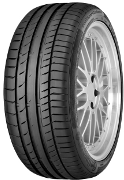Frequently Asked Questions About Tyres
What does 325/40 R21 mean?The tyre size that you find on the sidewall of a tyre will tell you important information such as the width, profile and diameter of your tyre. In this case, for the tyre size 325/40 R21, this means the following: 325 - the width of the tyre in millimetres. I.e. 325mm wide. 40 - the height of the sidewall as a percentage of the width. In this case 40% R21 - the diameter of the tyre's inner rim in inches. Basically what size of wheel this is designed to fit onto. In this instance it is a 21 inch wheel.
If you are looking for the recommended tyre pressure for 325/40 R21 tyres, you will find that this will depend on the manufacturer and model. Each vehicle manufacturer has their own tyre pressure recommendation for their model, that will deliver an optimal performance for your vehicle. Check the following if you are unsure what the correct tyre pressure is for your 325/40 R21 tyres Tyre label - this is often the best place to find your tyre pressure information. It is located on the door jamb on the driver’s side of the vehicle. It is a small rectangular label that provides the driver with the recommended tyre pressure and tyre sizes. Vehicle handbook - Quite often the vehicle handbook with contain a section that relates to the technical details for the tyre. This should include the required tyre size, load rating, speed rating and recommended tyre pressure.
The sidewall height of a 325/40 R21 tyre is calculated by using the profile information of the tyre size. In this instance 40. This tells us that it is 40% of the tyre's cross-section width. When looking at a tyre, the sidewall height is the distance between the tread line of the tyre and the rim line. Given that this tyre size has a cross-section width which equals 325mm, we can work out that the sidewall height is 40% of 325 – this comes to 130mm.
Yes, tyre sizes need to be exact. Tyres are an integral part of a vehicle and so require that they are produced to exact standards. As well as being the only part of a vehicle that is in contact with the road, many components of a vehicle rely on tyres. The speedometer requires the tyres to be precise so that it is able to accurately calculate the speed at which you are travelling. If the tyres are not exact or the wrong size you will get incorrect readings. Also, the handling, braking and suspension components of a vehicle requires accurate tyres so that they can deliver an optimal performance. Should the tyre size be inexact, your vehicle would not perform well and you could also find your safety when driving is compromised.
In a lot of cases, especially for front-wheel drive vehicles, the recommended tyre size from the vehicle manufacturer will be the front and back tyre sizes are the same. However, this is not always the case. Many rear-wheel drive vehicles often have the requirement for wider tyres on the read axle, this is to help with greater traction and optimised performance. To find out what the manufacturer of your vehicle recommends, the best thing to do is check your vehicle handbook. This should have all the information you need in regard to which tyre sizes are required for your vehicle.


